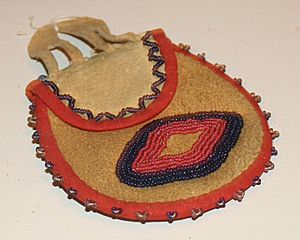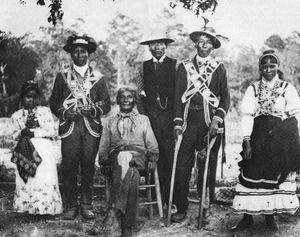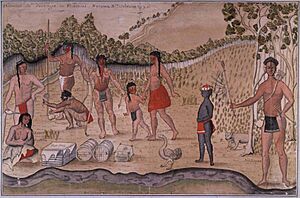Culture of the Choctaw facts for kids

The Choctaw culture has changed a lot over hundreds of years. It has been shaped by interactions with Spain, France, and England, but mostly by European-American influences. The Choctaws, also called Chahtas, are a Native American people. They originally lived in the Southeastern United States. They were known for quickly adopting new ways. They developed a written language and learned new farming methods. They also blended European-American and African-American lifestyles into their society. The Choctaw culture began with the Mississippian culture era of the mound builders.
Contents
Choctaw Family Groups: Clans
The Choctaw people had two main groups called Moieties: the Imoklashas (elders) and the Inhulalatas (youth). Each Moiety had several clans, or Iksas. There were about 12 Iksas in total. A Choctaw person's identity came first from their Moiety and Iksa. For example, they would say they were Imoklasha or Inhulata first, and then Choctaw. Children belonged to their mother's Iksa. This means their family line was traced through the mother, which is called matrilineal.
Some important districts were:
- Okla Hannalli (people of six towns)
- Okla Tannap (people from the other side)
- Okla Fayala (people who are widely spread out)
Some possible clan names, often linked to animals or nature, included:
- Wind
- Bear
- Deer
- Wolf
- Panther
- Holly Leaf
- Bird
- Raccoon
- Crawfish
Choctaw Beliefs and Spirits
The Choctaws believed in both a good spirit and an evil spirit. They may have worshipped the sun, which they called Hushtahli. They saw the sun as a powerful deity. It was believed to have the power of life and death. The sun was seen as watching over the earth. As long as its "flaming eye" was on someone, that person was safe. Fire, which looked like the sun, was also thought to be intelligent. It was believed to work with the sun and communicate with it. The word nanpisa (the one who sees) showed how much the Choctaw respected the sun.
Historians believe that the Choctaw's ancestors, the Mississippian people, put the Sun at the center of their beliefs. Choctaw leaders in the 1700s saw the sun as a living being. For example, Choctaw diplomats would only speak on sunny days. If it was cloudy or rainy, they would delay meetings. They often said they needed more time to talk, but they waited for the sun to return. They believed the Sun made sure all talks were honest. The Sun was a huge symbol of power and respect in many southeastern Native American cultures.
The evil spirit was called Na-lusa-chi-to ("black being" or "big black one") or Impashilup ("soul eater" or "ghost eater"). This spirit tried to harm people. Stories say it might appear as a shadow person.
While missionaries later introduced prayers, Choctaw prophets were known to speak to the Sun. Some Choctaw elders said that before missionaries arrived, they didn't have prayers. However, their hopaii, or prophets, would sometimes address the sun.
Choctaw Stories and Legends
Storytelling is a very important part of Native American societies. It's used for entertainment and to pass down history. Many stories also teach important lessons and values. This was true for the Choctaws too. Their stories told about their origins and the brave actions of heroes from the past. There are also many stories about animals like possums, raccoons, turtles, birds, chipmunks, and wolves.
The Choctaw people believed they came from the sacred mound of Nanih Waiya. This is part of their creation story. Another legend tells about the Choctaw tribe's journey led by a chief named Chata. These stories are still very popular among older Choctaws today. Younger Choctaws often enjoy tales about mischievous forest animals or how the wild forests were created.
One popular animal story is about a possum and a raccoon: A long time ago, when animals could talk, there were two brothers, Possum and Raccoon. Raccoon was jealous of Possum's long, colorful tail. One day, Raccoon told Possum he knew a way to make his tail even more beautiful. Possum was curious and asked how. Raccoon told him to go home and return in a few "moons" (months).
When Possum returned, Raccoon led him deep into the woods. They found a large hickory tree with a hole in its side. Raccoon told Possum to stick his tail into the hole. Possum did as he was told. Soon, Possum felt himself being tied to the tree. He got angry, but Raccoon convinced him it was necessary for his tail to become amazing.
Once Possum was tied, Raccoon went to the other side of the tree. After a few minutes, Possum felt pain and heat in his tail. Then the pain stopped. Raccoon told Possum to wait a bit longer and he would come back to untie him. Possum waited and waited, but Raccoon never returned. Possum called for help, and Squirrel came to set him free. When Possum pulled his tail out of the tree, he saw it was burned to a crisp. To this day, Choctaws believe Raccoon burned Possum's tail because he was jealous.
The Choctaw also have stories about little people. They say a little man, about two feet tall, lives in the thick woods. He is shy but sometimes playfully throws sticks and stones at people. Choctaw doctors say this little person, called Bohpoli (thrower), helps them make their medicines. These little people are also said to take young children into the forest to teach them how to become medicine men.
Another belief was about the will-o'-the-wisp, which they called "night-name." They thought it would braid horses' tails at night and ride them until the horses were exhausted or even died.
Choctaw Language
The Choctaw language is part of the Muskogean language family. Other languages in this family include Creek, Seminole, Chickasaw, Koasati, Alabama, and Mikasuki. In the early 1800s, many frontiersmen, like future U.S. President Andrew Jackson, knew the Choctaw language.
Over time, fewer young Choctaws spoke their native language. This was often because they were forced to attend boarding schools. In these schools, Choctaw children had to speak English, which made it very hard to keep their own language. However, there were also schools run by the Choctaws themselves. In these schools, some children still learned the language, though many of these schools became bilingual (teaching both Choctaw and English).
The Choctaw Alphabet
The written Choctaw language uses English letters. It was developed in the early 1800s as part of a program to help the Choctaw people adapt to new ways. There are different versions of the Choctaw alphabet. The three most common are the Byington (Original), Byington/Swanton (Linguistic), and Modern versions.
Byington (Original) Alphabet
Byington/Swanton (Linguistic) Alphabet
Modern Choctaw Alphabet
Choctaw Stickball: "Little Brother of War"

Native American stickball is one of the oldest field sports in the Americas. It was also known as the "little brother of war." This is because it was a very rough game and sometimes used instead of actual fighting. When different Choctaw communities had disagreements, stickball offered a "civilized" way to solve the problem. The first mention of stickball was in 1729 by a Jesuit priest.
Stickball games could have as few as twenty players or as many as 300. An observer named George Catlin once wrote about the game: It was common for six hundred, eight hundred, or even a thousand young men to play a game of ball. Five or six times that many people, including men, women, and children, would watch the game.
The goal posts could be anywhere from a few hundred feet to a few miles apart. Sometimes, the goal posts were even located inside each team's village. The playing field didn't have strict boundaries. The only limits were the two goalposts at each end. These could be from 100 feet to five miles apart, as was the case in one game in the 1800s.
The Mississippi Band of Choctaw Indians still plays stickball today. Every year, you can see stickball games at the Choctaw Indian Fair near Philadelphia, Mississippi. It's also played at the Choctaw Labor Day festival in Tuskahoma, Oklahoma, often on a modern football field.
Choctaw Traditional Arts
The Choctaw people are skilled in many traditional arts. They are known for their basket weaving and beadwork. They also have rich traditions of dancing and music. Their unique cuisine (food) is another important part of their culture. All these arts together help define the Choctaw as a special cultural group.
Images for kids






